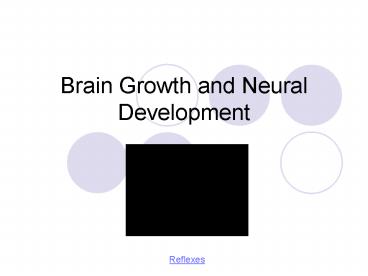Brain Growth and Neural Development - PowerPoint PPT Presentation
1 / 15
Title:
Brain Growth and Neural Development
Description:
Arial Times New Roman Wingdings Watermark Brain Growth and Neural Development Dynamic Action System Neurogenesis (step 1) Slide 4 Migration (2) Axon Growth (3 ... – PowerPoint PPT presentation
Number of Views:160
Avg rating:3.0/5.0
Title: Brain Growth and Neural Development
1
Brain Growth and Neural Development
Reflexes
2
Dynamic Action System
- Small changes during development lead to major
changes in structure and functioning later on - Prenatal and postnatal
- Changes attributed to plasticity
- What does this mean?
- Example ocular dominance
- 7 Primary Processes in Neural Dev
3
Neurogenesis (step 1)
- Proliferation of cells/prenatal
- Neurons produced in neural tube during prenatal
development - Glial cell production starts before
birth-continues beyond birth - forms a network that the neurons use to migrate
- Increases efficiency
4
(No Transcript)
5
Migration (2)
- Cells move through passive displacement (pushed
out by newly forming cells) - Active displacement- along the glial cell
structures - Plasticity- the degree to which a developing
structure or behavior is modifiable due to
experience. - Example cell destined for visual area misses
mark - ends up in auditory area
- differentiates
6
Axon Growth (3)
- Axons grow toward specific targets
- Guidance occurs as a result of neurotrophic
factors- - family of proteins - growth and survival of the
neuron - Chemical attraction or repulsion causes growth
cone of axon to change direction
7
Maturation (4)
- Neurons are formed and migrating before birth (by
end of 2nd trimester) - Neurons are functional but not optimally (at
adult levels)- we see inconsistent firing
patterns - Activity pattern changes with experience to
become more efficient and consistent - See Kaylin video
8
Synaptogenesis (5)
- Increase in synaptic connections
- Dendritic branching begins increasing shortly
before birth - These high levels are associated with infant
relflexes - E.g. visual synapses
- _at_10 of adult levels _at_ birth
- _at_ 8 months, synapses are at max levels
- _at_ 11-12 years, adult levels (50-60 of max level)
9
(No Transcript)
10
Decrease in of synapses (6)
- Big increase, then gradually decrease in number
after birth (8 mo) - Apoptosis- programmed cell death- predetermined
lifespan of the cell related to neurotrophic
factors
11
Decrease in of Synapses (6) -Pruning
- Pruning- increased activity in specific areas
associated with a decrease of the neuronal
network. - decrease in density occurs at the same time as
- regression of infantile reflexes
- acquisition of specific abilities
- seems to be a critical mass of synapses required
for onset of specific skills acquisition. - as skills are refined? pruning
12
Myelination (7)
- Responsible for increased wt size of brain
- Neurons in place after birth- axons become coated
with fatty substance after birth (Glial Cells). - Glial cells
- Taste, smell, touch are myelinated partially or
fully at birth - vision- process complete sometime around 5-8
months - language processing pathways
- begin around 12 months
- rapid expansion of myelin sheath around 15-18
months- Result? - myelination associated with acquisition of new
skills- speed of transmission - brain growth spurt- last trimester to end of 2nd
year - Additional growth spurt 5-8 years
13
MRI Studies
14
Brain Growth
- Size
- Functionally developed at birth
- _at_ birth brain weighs ¾ - 1 lb (25 of adult size)
- _at_ 6 months, 50 of adult size (1.5-2 lbs)
- _at_ 2 years 75 of adult size (2.25-3 lbs)
- Fetal Brain Growth
15
Why such growth?
- What accounts for increased size?
- Addition of glial cells?Myelination of the axons
- Shape
- As size increases- shape changes
- Deeper folds
- More convolutions
- Increases the surface area

